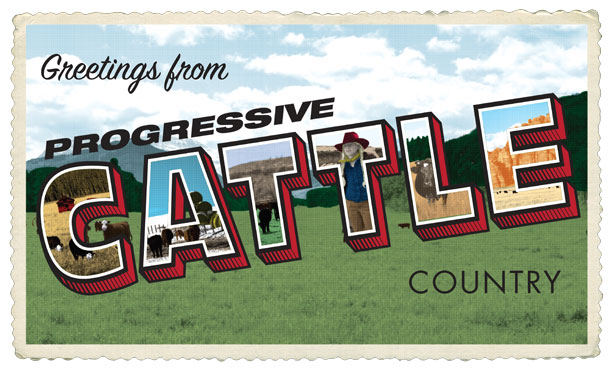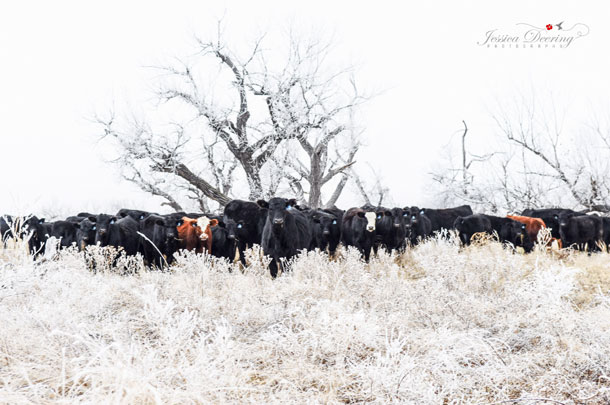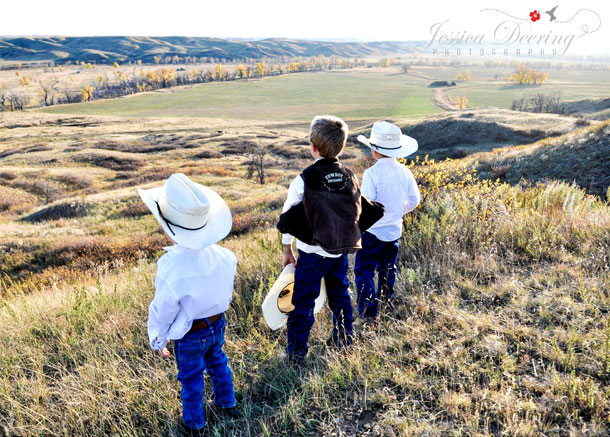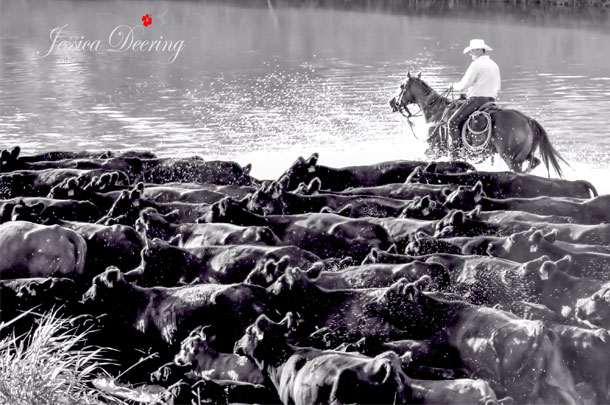Approximately 850,000 residents call South Dakota home, with roughly five beef cattle per resident.
Almost directly down the middle of the state runs the Missouri River, dividing the state between what is commonly referred to as East and West River. The difference between the two regions is vivid. East River boasts abundant cropland such as corn and wheat, as well as a large volume of swine, poultry and a few dairy operations.
However, West River, boasting roughly 25 to 30 percent of the entire state’s population, is where a majority of the state’s beef cattle population is located.

West River is home to predominantly cow-calf enterprises of all forms. From reputable seedstock producers to commercial producers, the region easily supports a large volume of cows and their offspring, and it has for decades.
“The land is in control of multigenerational families that have been in the cattle business since the original family member who homesteaded the land,” Dr. Kenneth C. Olson, extension beef specialist at South Dakota State University’s West River Ag Center, says. “There’s a lot of tradition, and producers are very proud of that tradition and of being multigenerational. For a lot of people in this region, that is all they have ever done and all they have ever wanted to do since childhood.”
The Slovek Ranch
Bill Slovek is a proud multigenerational rancher located 23 miles northwest of Philip. Upon graduation from Black Hills State University in 1979, Slovek bought land adjacent to his parents’ ranch. When his father passed, he merged the two pieces of land and has been adding to it ever since.
Since taking over the operation, he has exponentially grown the business and expanded his property lines when he had the opportunity to do so.
Today, alongside his wife Pennie and son Bo, they manage over 850 cows across more than 13,000 acres of grassland, 90 percent of which are a hybrid Angus-Simmental cross, and the remaining 10 percent are registered Angus.

The Sloveks sell about 80 bulls a year along with some bred heifers at their annual production sale. Not only do they rely on their steadfast bulls for live cover, they also artificially inseminate, a practice Slovek adopted in 1984.
Because of their deliberate genetic management and growth strategies, what doesn’t get sold in the annual production sales will be reincorporated into the herd under retained ownership until they can be sold as a fat animal.
In addition to a stringent genetic management protocol, the Sloveks dedicate ample time as stewards of the land, which includes a management-intensive rotational grazing practice, recycling of all farm lubricants and numerous efforts to reduce invasive species in order to restore the native grasses.
These land management practices earned them recognition as the 2012 Region VII Environmental Stewardship Award Program (ESAP) winner during the 2012 Cattle Industry Conference in Denver.
The Deering Ranch
Approximately 110 miles west of the Sloveks resides fourth-generation rancher, Gary Deering just outside of Hereford. He and his wife have three boys on the same ranch that his great-grandfather, Frank Wurnig, homesteaded in 1911.
After spending some quality time with his grandfather George Wurnig on the ranch during his teenage years, Deering felt a fire ignite in his soul; he wanted to ranch.
Deering credits the longevity of the operation to the strong will of his ancestors, especially that of George and his wife Marie, who is still alive with a sharp mind at the age of 97.
George and Marie took over the operation – and a surmountable debt – after the 1930s when times were tougher than ever. Because of Marie’s dedication to the family business, they successfully came out of that era and were able to pass the operation on to the next generations.

About 15 years ago, with the blessing of his revered grandfather, Deering partnered up with his parents and began purchasing cattle together. Since then, they have almost tripled the operation. When Deering isn’t ranching, he is advocating for the state’s cattlemen as the current vice president of the South Dakota Cattlemen’s Association.
Beef cattle country
“We have strong grass [in West River, South Dakota], and that’s why it’s beef cattle country,” Olson says. “Most of the land is not suitable for farming, but it is really good range land which makes it really good beef cattle country.”
“The grasses out here are outstanding, second to none,” Deering also notes. “The way we can put pounds on some calves and cattle with our grass is very powerful.”
Olson emphasized that the grass in this part of the state is highly nutritious and cures off well, which is a huge benefit to all beef cattle producers that call West River home. Despite the regular droughts producers face, there seems to always be grass and hay within reach, Deering notes.
“They raise a lot of feed up on some of the projects, such as the Belle Fourche water project with Orman Dam,” he says. “If you go 150 to 200 miles east of us, there is usually an abundance of feed there as well."
"We’ve certainly sent cattle east of us before, east of the river – we are only 250 miles from getting into the tall grass prairie [in northeast South Dakota] where they can grow an ungodly amount of feed.”
But, as Slovek notes, the country is relatively self-sustaining, which often limits the need to bring in feed.
“It’s good cattle and grass country,” Slovek reiterates. “We can actually raise quite a bit of grass with not too much rain if we get it at the right time.”
A lot of room for good grass and lack of urban sprawl is what Slovek credits as another key benefit to raising cattle in West River. But that lack of urban sprawl also creates quite the distance between folks.
“Out here, a neighbor could live 30 miles away from you, and you can still consider them a neighbor,” Slovek says. “A lot of places of the world, many people don’t know their neighbor 2 miles away, but out here, you can be 20 to 30 miles away, you’re still considered a neighbor.”
Despite having genuine neighbors, Olson notes the remoteness that is unique to this region can also present some challenges for producers.
“It takes a lot of land to support one ranching family, so ranches are big, and distances between neighbors are long. Distance to markets can be long, and distances to town or wherever a producer needs to go to conduct business or pick up supplies is often a ways out,” Olson says.
While the commute might take a bit for anyone in this part of the state, Deering notes it is a blessing to be living and working in such a lightly populated region.
“One of the reasons we’re so blessed – and we might want to keep this a secret – we’re going to see some urban sprawl but we haven’t seen it yet like in other parts of the country,” Deering says. “A lot of states are facing some challenges with urban sprawl that we just aren’t yet.”
Weather
Ask an agriculturalist from any part of the country or world, and the topic of weather will likely come up as a challenge to their operation. However, Mother Nature has a hold on West River, South Dakota unlike most other places.
“It could be 110ºF and dry as a desert where we see prairie fires like we had this fall [of 2016] and then come winter, it can be 30 below zero with wind chills lower than that,” Slovek says.
For folks west of the Missouri River, 2017 was rung in to the tune of high winds, temperatures falling well into the negative double digits – with even lower wind chills – and ample snow. In mid-January, as Deering points out, the mornings leading up to our conversation had been holding firm at 15 below zero at his homestead located in the southern portion of the region.
“I think it’s probably some of the biggest ranges of temperatures that stock will face probably anywhere,” Deering says.
“The weather kind of dictates, at times, what you do, why you do it and when you do it, [but] it is always going to be that way. Maybe that is why there are only 800,000 people in South Dakota,” Slovek says with a chuckle.
Resiliency of the producers through Storm Atlas
While there may not be many people, the few that are here are notably resilient. October of 2013 was a testament to that resiliency to many producers in West River, South Dakota.

Winter Storm Atlas began on Oct. 3, first as a wave of rain followed by 5 feet of heavy, blowing snow before finally subsiding on Oct. 5.
Atlas, as Slovek aptly puts it, hit at a time when the stars were aligned perfectly wrong.
“It was one of those events that you have to kind of live it, see it, or you wouldn’t believe it,” Slovek says. “We had a really mild fall, so most cattle were still out in summer pasture, and we hadn’t even really had a hard freeze yet so they really hadn’t haired up at all for the winter.
You put it all together – calf was still on the cow and sucking her down, they didn’t have their winter coat, they weren’t acclimated to cold weather yet and still out on summer pastures because it was such a mild fall, and it was just a recipe for disaster.”
“Atlas was awful,” Deering reflects. “They call it the 100- or 500-year storm, I don’t know what it is, but I hope it never happens again.”
Slovek reflects upon that storm with a solemn tone in his voice.
“We probably had 1100 animals on our land when the blizzard hit and when the storm was done, there was probably four that were still on our place. Everything drifted out, but we had about that many of the neighbor’s cattle that drifted in,” Slovek recalls. “Everything just drifted until they died or found protection.”
After the storm subsided, he bunched up the 2,000 cattle that had made their way to his land into one small pasture and fed them.
“We just let them rest for a couple days because they were just so mentally and physically exhausted that they didn’t want to move other than to eat.”
While letting the cattle on his property rest, many of which weren’t his, Slovek ventured out. While he had been through many blizzards before, some of which he recalled seemed much worse than this one, he soon realized just how unfit the cattle were for the extreme weather to hit when it did.
“It would just make you sick to go out and see all the dead cattle, even if they weren’t mine,” Slovek humbly recalls. “When the cattle took off, if they didn’t drift to good protection, it was just a trail of death."
"The weak ones started dying, then a mile or two more there’d be more. In a lot of cases, the whole herd drifted out and got stuck, and if the strong ones didn’t drift out and find a good spot, eventually, none of them were strong enough.”
Some producers lost a few head, others lost 80 to 90 percent of their herds and some lost every head they owned.
“The losses were devastating, because so many of those calves would have been ready to be sold or had been consigned later that month and were probably going to be sold at a record, or near record, high price at the time,” Slovek says.
Despite having neighbors up to 30 miles away, Slovek and 10 other nearby producers united together to help sort through the surviving cattle. They gathered everything together and sorted off until everyone had their respective herds.
“We didn’t get them all right, but I’d say we got about 98 percent right,” Slovek says. “It was kind of like, ‘Hey, we’re all in this together.’ After that, if we came across one that wasn’t ours, everyone would just call up the neighbor, and eventually we got everything straightened out.
“When we had finished sorting cattle that night, everybody came to the house. We just sat around and ate, drank and talked. It just needed to be done, but it certainly united people,” Slovek recalls.
The days, weeks and months following were tough. Good neighbors and a united community – both near and far – helped make the bleak situation easier. High cattle prices in the years following benefited those who had surviving herds but made it tough for those who were trying to repopulate. At the end of the storm, though, every producer affected put their boots on and went back to work.
“I have the utmost admiration for my friends, my neighbors, the folks of this region that were able to keep going in the face of such tragedy,” Deering says. “It made me very proud, because I knew the folks of this region were resilient, but even in the face of building a family and a ranch to having nothing, the people out here still remain strong, and I am very proud to be a part of such a community.”
Outlook of beef cattle in South Dakota
West River, South Dakota is home to predominantly cow-calf producers who have done a lot to keep genetically improving their cattle, Olson says. As such, this region is home to high-quality cattle “that are, in my mind, the envy of the industry.”
“When a cattle feeder is looking for quality calves because he wants to put out the kind of cattle that’ll perform well on the lot and grade well if they sell them on the rail, they come to the northern plains. West River, South Dakota is the heart of that northern plains country when they want quality cattle,” Olson says.
The land is not conducive to growing corn, so most cattle leave the region for East River or other states to be fed, Olson notes. New varieties of grains and crops offer up even more opportunity for the region despite the extreme climate, Deering notes.
However, for him, the most promising opportunity looking forward for the region lies in the demographical moves of other key players of the U.S. beef industry.
“We’re also very blessed in the potential for not only West River, but the state as a whole in that, unless they move us, we’re always going to be right in the heart of the nation,” he says. “Packing houses will be centered close to us within a 300-some-odd-mile radius very soon, I would say – so we will be able to ship shorter distances than many other regions of the country.”
Standing as the fifth-largest cattle state by population coming into 2017, Deering predicts that while South Dakota is a part of the beef conversation now next to the other large beef states such as Nebraska, Kansas and Texas, South Dakota will be inside the top four soon.
“The opportunities and the potential going forward are just outstanding,” he says with a strong sense of pride. “I have three young boys, 10, 8 and 6, and this potential means we can likely see operations being passed down another two, three or four generations like it was passed down to me. That’s exciting.”
Regardless of what the future may bring, West River, South Dakota is a land of opportunity for many reasons, namely in the strong people that are united through producing cattle.
“The thing about western South Dakota is a lot of good people and a lot of good cattle,” Slovek summarizes. “There’s not a lot of people, but the ones that are here are good ones. Situations such as Atlas just make it a closer-knit group of good people.” ![]()
PHOTO 1: Ranchers in West River, South Dakota, are a product of generations’ worth of good grass, good cattle and good people.
PHOTO 2: Cattle of this region must be hardy to survive the extreme weather that is common in any given year.
PHOTO 3: The Deering boys, Porter age 9, Shea age 8 and Dawson age 6, are learning the family business firsthand. Gary Deering is optimistic their operation can be handed down to these boys and generations after.
PHOTO 4: Good grasses are abundant in West River, South Dakota. Photos by Jessica Deering.

-
Danielle Schlegelk
- Freelance Author
- Whitewood, South Dakota
- Email Danielle Schlegel







